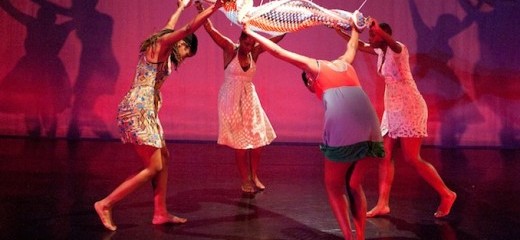
Women With Saying Power: The Requisite Movers
by Kirsten Kaschock
During the after-show Q&A, the movement artists and choreographers calling themselves The Requisite Movers sat on the stage to field questions. An audience member commented that this image—of ten Black female artists laughing and talking about their processes—was the last in a series of striking ones from the evening.
Lela Aisha Jones and Deneane Richburg combined forces in 2010 to create The Requisite Movers. This performance featured their work as well as the choreography of two other artists with ties to Philadelphia: Saroya Corbett and Dina-Verley Sabb-Mills.
Jones’s The Beauty of My Father began the show and featured two women in white making fluid, muscular gestures of gathering. They also stared defiantly into the audience, wiping their noses, then slapping their arms and thighs. The combination of controlled elegance with what Jones referred to later as “urban beauty” set the tone for the evening, as did the juxtaposition of the two performers’ styles: Richberg grounded and regal, Danielle Currica sharper—more bird-like.
Currica explained why the program listed her and her fellow performers as movement artists rather than dancers. These choreographers, she said, had instructed her to learn and “do the movement, but not like [them].” The women on both sides of her nodded as she spoke. This aesthetic choice—to treat performers as individual voices rather than as material—was emphasized by both non-identical costume choices and ensemble dancing synchronized by intention rather than by cookie-cutter unison.
The pieces varied as much as the women who moved through them. In addition to the first, Jones created two other works. In Airlooms, four women transformed the stage with a multi-colored afghan and sixteen translucent balloons—creating corridors that reframed their shoulder-touching and small hand gestures to an eclectic range of music, although the performers at times seemed more concerned with the props than with one another. Jones’s Mining Black Water ended the show with a trio in green, weaving through each other and around the stage in subtle eddies.
Saroya Corbett’s Thickness interrogated the images of Black women’s bodies in hip-hop videos and their visceral effects on a soloist. Three women performing in flowing traditional dress danced to Jill Scott’s “Thickness” but did not overtly acknowledge the song’s body-critical lyrics. A single woman in a white shirt then replaced the trio. A barrage of images coming into focus behind the soloist—mostly video of women’s be-thonged and shaking backsides accompanied by fully-dressed, laughing men—eventually overpowered her trembling form.
Dina-Verley Sabb-Mills’s (happy) life stood out in its precision. Sabb-Mills created the solo to work through the loss of a loved one, and her physical translations of spoken word perfectly walked the tightrope between the literal and the abstract. Sabb-Mills, a gifted performer, danced as much with her facial expressions as with her long limbs and (at one point) giggling torso. Excerpted from a longer work, this piece ended too quickly.
Deneane Richburg’s Living Past Re-Memory found its source in Toni Morrison’s Beloved. This duet, featuring an intense and cloaked Lela Aisha Jones and a red-dressed Shaness Kemp explored repeated arching floor phrases and tortured gestures, as Kemp reached to her back for imagined “chokecherry tree” scars. A quoted passage provided part of the soundscape, as did Jones’s haunting voice. With only her face, throat, and protruding foot visible, as she slowly circled the stage, Jones’s concentration contrasted darkly with Kemp’s powerful sadness. This work’s unapologetic use of stark costuming, lighting, and staging evoked the Greek dramas that Toni Morrison has acknowledged inform her texts.
The pieces, though wildly different, shared a preoccupation with voice. The work of these women felt less like abstract explorations than communications. These artists have something to say, and they are worth listening to—both when they speak informally about their processes and during performance, when what they say is how they move.
The Requisite Movers at The Performance Garage, October 14 & 16. No further performances.
By Kirsten Kaschock
October 28, 2011

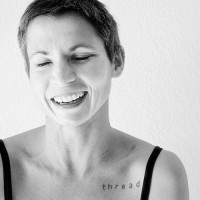
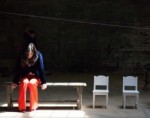
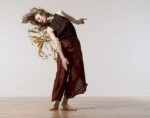
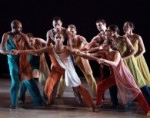

.png)


